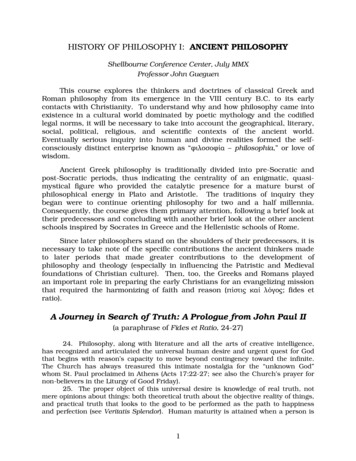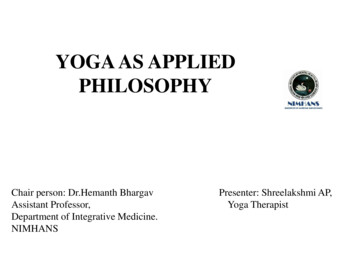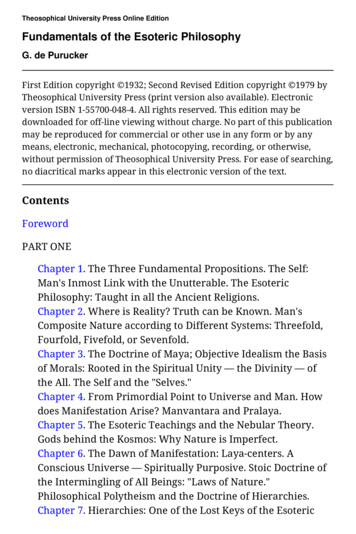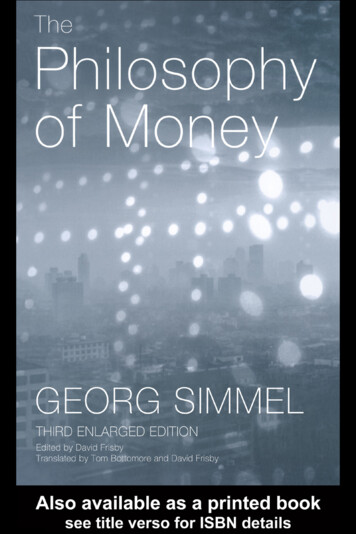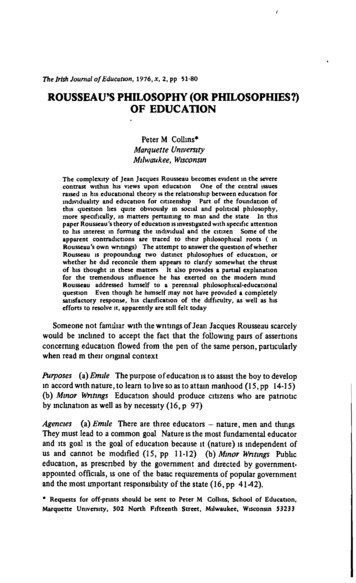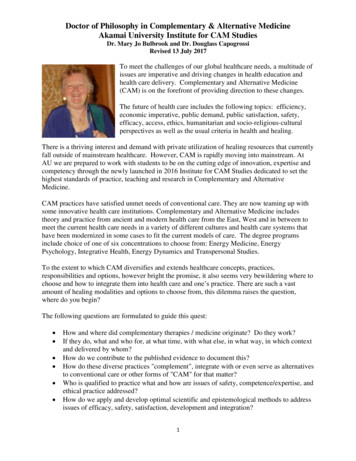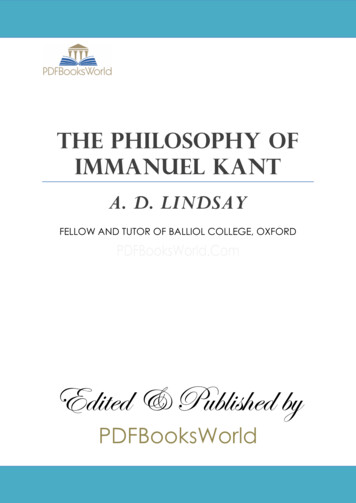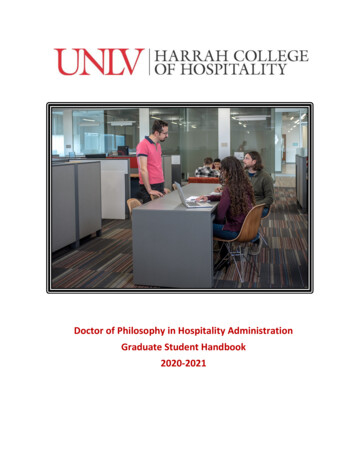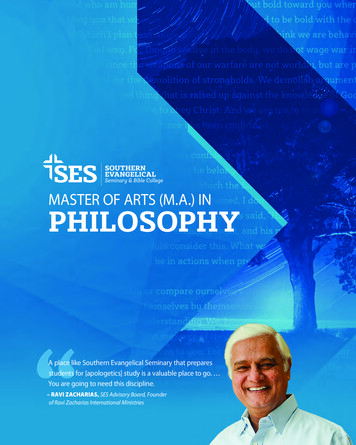
Transcription
The Philosophy of Sex
Also by Alan SoblePornography, Sex, and FeminismSexual InvestigationsThe Philosophy of Sex and Love: An IntroductionThe Structure of LovePornography: Marxism, Feminism, and the Future of SexualitySex, Love, and Friendship (editor)Eros, Agape, and Philia (editor)
The Philosophy of SexContemporary ReadingsFourth EditionEdited byAlan SobleROWMAN & LITTLEFIELD PUBLISHERS, INC.Lanham Boulder New York Oxford
ROWMAN & LITTLEFIELD PUBLISHERS, INC.Published in the United States of Americaby Rowman & Littlefield Publishers, Inc.4720 Boston Way, Lanham, Maryland 20706www.rowmanlittlefield.com12 Hid’s Copse RoadCumnor Hill, Oxford OX2 9JJ, EnglandCopyright 2002 by Rowman & Littlefield Publishers, Inc.All rights reserved. No part of this publication may be reproduced, stored in a retrieval system, or transmitted in any form or by any means, electronic, mechanical, photocopying, recording, or otherwise, without the prior permission of thepublisher.British Library Cataloguing in Publication Information AvailableLibrary of Congress Cataloging-in-Publication Data AvailableISBN 0–7425-1345–9 (alk. paper)ISBN 0–7425-1346–7 (pbk : alk. paper)Printed in the United States of AmericaTMThe paper used in this publication meets the minimum requirements ofAmerican National Standard for Information Sciences—Permanence of Paperfor Printed Library Materials, ANSI/NISO Z39.48–1992.
For Rachel Emoke, “the finest girl”Love always from your Daddy
CONTENTSPREFACEINTRODUCTION: THE FUNDAMENTALS OF THEPHILOSOPHY OF SEXAlan SoblexixviiPART 1: CONCEPTUAL ANALYSIS1. Are We Having Sex Now or What?Greta Christina32. Sexual PerversionThomas Nagel93. Sexual ParadigmsRobert Solomon214. Sexual Behavior: Another PositionJanice Moulton315. Plain SexAlan Goldman396. Sex and Sexual PerversionRobert Gray577. Masturbation: Conceptual and Ethical MattersAlan Soble67vii
viiiContentsPART 2: HOMOSEXUALITY8. Is Homosexual Conduct Wrong? A Philosophical ExchangeJohn Finnis and Martha C. Nussbaum9. Against Homosexual LiberationMichael E. Levin9710310. A Christian Homosexuality?Edward Vacek, S.J.12711. Homosexuality: The Nature and Harm ArgumentsJohn Corvino13512. Defending MarriageCheshire Calhoun147PART 3: ABORTION13. Abortion and the Sexual Agenda: A Case for ProlifeFeminismSidney Callahan14. Abortion: Is a Woman a Person?Ellen Willis177191PART 4: KANT AND SEX15. Duties towards the Body in Respect of Sexual ImpulseImmanuel Kant19916. Sexual Morality and the Concept of Using AnotherPersonThomas A. Mappes20717. Sexual Use and What to Do about It: Internalistand Externalist Sexual EthicsAlan Soble22518. The Morality of Sex: Contra KantIrving Singer259PART 5: RAPE AND HARASSMENT19. Is This Sexual Harassment?Robin Warshaw275
Contents20. Sexual Harassment in the Law: The DemarcationProblemMane Hajdinix28321. How Bad Is Rape?H. E. Baber30322. The Harms of Consensual SexRobin West31723. Antioch’s “Sexual Offense Policy”: A PhilosophicalExplorationAlan Soble24. Consent and Sexual RelationsAlan Wertheimer323341PART 6: PORNOGRAPHY AND PROSTITUTION25. Talk Dirty to MeSallie Tisdale36926. ObjectificationMartha C. Nussbaum38127. Pornography and the Social SciencesAlan Soble42128. Should Feminists Oppose Prostitution?Laurie Shrage43529. What’s Wrong with Prostitution?Igor Primoratz45130. Whoring in UtopiaPat Califia475SUGGESTED READINGS483INDEX501ABOUT THE CONTRIBUTORS509
PREFACEI have been teaching undergraduate courses in and writing about thephilosophy of sex and love since 1976. That comes to more than twentyfive years: a good portion of my adult life (almost half) and all my postgraduate professional life. You might think that I would be sick of thesubject, if not of sex itself, by now—say, by a kind of excitatory habituation. To some extent that has happened.1 Nevertheless, I still experiencea scholarly-sensuous frisson whenever I open an envelope or an e-mail inwhich a colleague has sent to me, for comments or perusal, a new pieceon sexual morality (most recently, when Igor Primoratz sent me his enticing “Sexual Morality: Is Consent Enough?”);2 or whenever I pagethrough a professional journal or an anthology and unexpectedly find anexploration of sexuality (for example, Louise Collins’s unfortunatelysomewhat tedious “Emotional Adultery: Cybersex and Commitment”);3or whenever, browsing through a university press catalogue or the NewYork Review of Books, I discover yet another scholar bringing innovativeideas and a fresh perspective to the field (David Archard’s Sexual Consentcomes to mind immediately).4 This revised, fourth edition of The Philosophy of Sex: Contemporary Readings contains the kind of philosophical investigations of sexuality that have sustained my interest in the field duringall these years in the face of a suspicion (and the fact) that some philosophers, theologians, and other writers have, in their published work, beenmerely repeating the same old tired formulas over and over again.The second edition of The Philosophy of Sex (1991) was an 80-percent revision of the first edition (1980); the third edition (1997) was also an 80percent revision of the second. By contrast, this fourth edition (2002) isabout a quarter or so revision of the third edition—which is supposed toinform you, my students, colleagues, and other readers, that I was happywith the third edition, although not perfectly happy with it. This fourth edition is the largest Philosophy of Sex ever published, containing thirty chapters (or thirty-one, depending on how you do the counting), therebyxi
xiiPrefaceproviding, in the resulting mixture, more substance and variety for students studying the philosophy of sexuality and for researchers working inthe field. It newly contains, for example, my introductory essay “The Fundamentals of the Philosophy of Sex,” written to ease students into, andprovoke them about, the subject matter. This edition also contains otheressays that are appearing in the collection for the first time, plus a muchexpanded “Suggested Readings” section. Once again the core theoreticaland historically important essays that are central to contemporary philosophy of sex are included (four of which were originally and surprisingly published in the dignified pages of the Journal of Philosophy):Thomas Nagel’s “Sexual Perversion,” Robert Solomon’s “Sexual Paradigms,” Janice Moulton’s “Sexual Behavior: Another Position,” RobertGray’s “Sex and Sexual Perversion,” and Alan Goldman’s “Plain Sex”(from the prestigious journal Philosophy and Public Affairs).The bulk of the fourth edition of Philosophy of Sex falls properly in thearea of applied philosophy of sex or, more generally, applied philosophy, applied ethics, and gender studies (so the book could be used inthose sorts of courses as well as in courses that concentrate on the philosophy of sex). Some of the essays I have chosen to include in this volume are very good, even excellent; others, I think, are probably wrong,even if provocative. But this latest version of Philosophy of Sex would be anextraordinarily boring book were I to assemble together only what I personally like, find compelling, or sympathize with ideologically. Such amonistic collection, furthermore, would not serve well the interests ofstudents who are attempting to learn about the philosophy of sex or ofscholars who utilize this text for research, and it would not do justice tothe richness of sexual philosophy. Hence there are essays in this anthology that are critical and supportive of homosexuality, abortion, prostitution, and pornography, which makes the book unlike a large number ofrecent collections in sex and gender studies that are merely platformsfor partisan views.5The section on conceptual analysis (Part 1) begins with a sweet and souressay by Greta Christina, who exhibits how the paradigmatically philosophical task of providing criteria for the identification of sexual acts alsoarises in (some of) our sexual lives.6 “What is sex?” (definitionally and descriptively) is the question addressed in the other essays of Part 1: ThomasNagel focuses on the sophisticated psychological nature of human sexualinteraction; Robert Solomon explores the expressive functions of sexualbehavior; Janice Moulton exposes what is false and misleading, from awoman’s perspective, in Nagel’s and Solomon’s accounts of human sexuality; Alan Goldman attempts to define “sexual desire” and “sexual activity” by discovering the lowest common denominator of all sexual events;Robert Gray illuminates the conceptual relationship between sexual activity and sexual pleasure and explains how this bears on our understand-
Prefacexiiiing of sexual perversion; and in my contribution to Part 1, I examine conceptually and ethically the much-maligned yet nearly universally practiced(among males, at least) act of masturbation. (You might rememberWoody Allen’s joke: “Why are you such a good lover?” Answer: “I practicea lot when I’m alone.”)In Part 2, the pieces by John Finnis and Michael Levin express severedoubts about the morality, wisdom, and normality of homosexuality,7while those of Martha Nussbaum and John Corvino offer defenses ofgay and lesbian sexuality. Ed Vacek’s prescient paper presents an earlystatement of a position that has lately been growing in popularity andvisibility, namely, that the tenets of Christianity do not entail that lovingand consummated homosexual relationships are morally wrong.8Cheshire Calhoun, in her recent essay “Defending Marriage,” criticallyanalyzes several arguments that attempt to defend same-sex marriage,and concludes that such marriages are essential for the full citizenshipof gay men and lesbians. Of course the analytic essays of Part 1 of thisvolume on the nature of sex and perversion have implications for thesedisagreements over homosexuality, as they do for all the other topicsdiscussed later in the volume.Both abortion and sexuality have been written about abundantly, butlargely independently of each other. For this reason, I have reserved Part3 of the book for two essays that nicely examine an issue that has been,among philosophers, relatively neglected: Sidney Callahan and EllenWillis explore the logical, psychological, and social connections betweenthe abortion controversy and contemporary sexual norms.9In Part 4, which is new to this fourth edition of Philosophy of Sex, the important concept (and practice) of the “sexual use” of one person by another is investigated. Part 4 begins with a classic statement by theGerman philosopher Immanuel Kant (1724–1804) about the essentiallyobjectifying or instrumental nature of human sexual interaction. (Thischapter is the only one in the book that cannot be called a “contemporary reading,” in violation of the book’s subtitle. I include it becausethere has lately been a good deal of writing about Kant and sexuality—see the “Suggested Readings”—and it is helpful to have some of whatKant wrote about sex conveniently available.) Thomas Mappes and I explore, in separate essays, what is implied about the morality of sexual behavior if we take Kant’s metaphysics of human sexuality seriously (orsemiseriously) and also hold to some version of the Second Formulationof Kant’s Categorical Imperative. Thus both essays ask how and whensexual activity could be morally permissible if the persons involvedwanted to follow Kant’s injunction never to use another person sexuallymerely as a means. (This is a topic brought up briefly earlier in the volume by Alan Goldman).10 An essay by Irving Singer closes Part 4, inwhich he registers strong disagreement with Kant’s characterization of
xivPrefacesex as inherently instrumental and objectifying.11 Clearly, the theoretical and practical discussion of sexual use and sexual objectification inPart 4 is especially relevant to the topics addressed in Parts 5 and 6 of thisbook: rape, harassment, pornography, and prostitution.Part 5 is devoted to questions that arise about rape, date rape, and sexual harassment. Robin Warshaw, by carefully presenting case studies ofpossibly sexually harassing behavior, shows us that analytic tangles, andhence legal and social uncertainties, plague this phenomenon. ManeHajdin tries to clear up this perplexing territory by suggesting how a demarcation criterion, one that reliably distinguishes acceptable from unacceptable sexual advances, might be devised. H. E. Baber compares theharms caused by work in our society and the harms caused by rape orsexual assault and reaches a surprising conclusion. Robin West exploresanother problematic distinction, that between nonconsensual sexual activity and sexual activity that is consensual yet still engaged in undersome sort of pressure and is in that way harmful, especially to women’sautonomy. Two additional essays have been added to Part 5 of this edition. My essay on Antioch University’s “Sexual Offense Policy” analyzesthe school’s procedures designed to reduce or eliminate date rape oncollege campuses. And Alan Wertheimer’s essay insightfully pondersand questions the meaning, moral power, and even the relevance of“consent” in sexual contexts. Note that Wertheimer and Mappes discusssimilar cases in probing the influence of coercion and deception on themorality of sexual relations.Prostitution and pornography—which both involve, in their own way,performing sexual acts for compensation, and arguably involve the sexual use and objectification of (mostly) women—are the last of the special topics, analyzed by two sets of three essays each in Part 6. In heressay, Sallie Tisdale presents a feisty and enlightening look at pornography from a woman’s perspective.12 Martha Nussbaum tackles the enormous and difficult task of distinguishing, both analytically and morally,the various kinds of sexual objectification that are represented in or carried out by pornography and literature (and, by extension, the objectification that also occurs in our lives). My contribution to this section isan essay that i
But this latest version of Philosophy of Sex would be an extraordinarily boring book were I to assemble together only what I per-sonally like, find compelling, or sympathize with ideologically. Such a monistic collection, furthermore, would not serve well the interests of students who are attempting to learn about the philosophy of sex or of scholars who utilize this text for research, and it .
